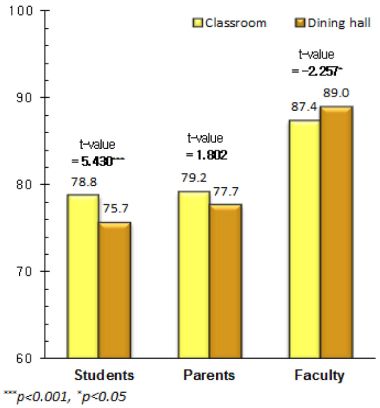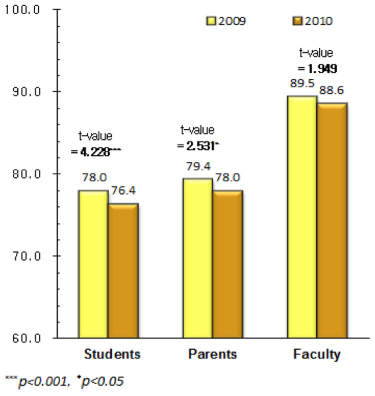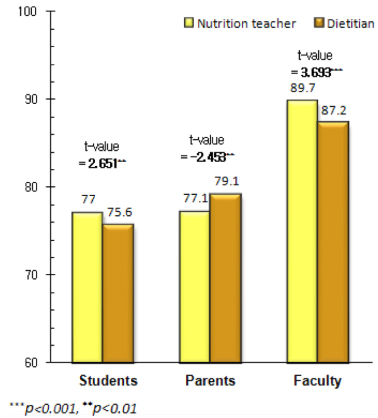Evaluation of the Quality Attribute and Satisfaction on School Foodservice in 2010
- Affiliations
-
- 1Department of Food & Nutrition, Yonsei University, Seoul, Korea.
- 2Department of Foodservice Industry, Hanyang Woman's University, Seoul, Korea.
- 3Department of Food & Nutrition, Shingu University, Kyeonggi, Korea.
- 4Research Center for Food, Nutrition and Foodservice Management, Yonsei University, Seoul, Korea. tilooc@chol.com
- KMID: 2267558
- DOI: http://doi.org/10.5720/kjcn.2013.18.5.491
Abstract
- The purposes of this study were to analyze the quality attributes, quality factors and customer satisfaction in school foodservice and to provide suggestions for improving school foodservice environments. The survey was distributed to different respondents (5,771 students, 2,045 parents, and 1,981 faculty members) at different types of schools (elementary school, middle school, and high school) on September 2010 in 16 cities and provinces. The data were analyzed using SPSS for descriptive analysis, one-way ANOVA, t-test and multiple linear regression analysis. First, all foodservice quality attributes were significant different by respondents and the faculty had higher scores than parents and students. A comparison of scores by respondents and distribution place demonstrated that classroom of student and parents had a higher score for quality attributes. The overall satisfaction with school foodservice was significant different by respondents and higher for classroom than for dining hall for student and parents. In comparison of annual data, there was decreased overall satisfaction and quality attributes in student and parents. Second, in the regression results, which showed the effects of the foodservice quality attributes on overall satisfaction by respondents and distribution place, improvements of 'food taste', 'pleasant foodservice environment', and 'kindness of employee' would increase satisfaction in most of the respondents. Third, the overall satisfaction with school foodservice was higher for nutrition teachers than dietitians for students and faculty. Therefore, the operators will need to make different efforts based on each customer needs to improve the overall satisfaction on school foodservice.
Figure
Cited by 5 articles
-
Perception of Use of Environment-friendly Agricultural Products during School Foodservice of Mothers of Elementary School Students in Gyeonggi
Young-Un An, Myung-Hee Kim, Mi-Kyeong Choi, Mi-Hyun Kim
Korean J Community Nutr. 2018;23(3):234-242. doi: 10.5720/kjcn.2018.23.3.234.Improving Perception and Satisfaction on Middle and High School Foodservice: The Role of Student Participation Program in Serving School Meals
Jeong-Eun Park, Kyung-Suk Choi
Korean J Community Nutr. 2018;23(3):243-256. doi: 10.5720/kjcn.2018.23.3.243.Development of Model for 「The Survey on School Foodservice Program」
Hae-Young Lee, Bo-Sook Yi, Jina Cha, Sun-Ok Ham, Moon-Kyung Park, Mi-Nam Lee, Hye-Young Kim, Haeng-Hwa Kang, Jin-Wook Kwon, Yun-Hui Jeong
Korean J Community Nutr. 2019;24(1):60-76. doi: 10.5720/kjcn.2019.24.1.60.Effects of students' satisfaction with school meal programs on school happiness in South Korea
Sooyoun Kwon, Oksun Kim, Youngmi Lee
Nutr Res Pract. 2018;12(4):342-347. doi: 10.4162/nrp.2018.12.4.342.Exploratory study on effect of eco-friendly program in high school foodservice on adolescents' dietary behavior and satisfaction with foodservice
Seyoung Ju, Deokhee Song, Hyeja Chang
J Nutr Health. 2017;50(5):494-503. doi: 10.4163/jnh.2017.50.5.494.
Reference
-
1. Choo YJ, Ryu SH, Yoon JH. Dietitian's job satisfaction and perception of foodservice quality in elementary schools. Korean J Nutr. 2006; 39(2):192–200.2. Jang HR, Kim HYL. Survey on the satisfaction degree for school lunch program of elementary school students in Yongin. Korean J Food Nutr. 2005a; 18(2):155–160.3. Jang MR, Kim JY. Comparison of importance and performance to the school lunch service according of male and female middle school students in the Gangwon province. J Korean Diet Assoc. 2005b; 11(1):95–104.4. Kim KA, Kim SJ, Jung LH, Jeon ER. Degree of satisfaction on the school foodservice among the middle school students in Gwangju and Chonnam area. Korean J Soc Food Cookery Sci. 2002; 18(6):579–585.5. Yi BS. Comparative analysis of the quality attributes affecting students' satisfaction on school lunch service of middle school by year. Korean J Community Nutr. 2012; 17(4):479–493.6. Lee HS, Jang MH. Survey of students satisfaction with school food-service programs in Gangwon province. Korean J Food Nutr. 2005; 18(3):175–191.7. Lee KH, Park ES. School foodservice satisfaction and menu preferences of high school students: Focused on Iksan, Cheonbuk. Korean J Community Nutr. 2010; 15(1):108–123.8. Ministry of Education, Science and Technology. Survey on satisfaction with school foodservice. 2009. p. 6–8.9. Ministry of Education, Science and Technology. School meals hygiene guidelines. 2010. p. 27–41.10. Mo SJ, Suh JS, Lyu ES. The evaluation of the perception of students and employees for foodservice characteristics of in high schools in the Busan area. Korean J Food Cookery Sci. 2005; 21(2):250–262.11. Oh YM, Kim MH, Chung JS. The study of satisfaction, meal preference and improvement on school lunch program of middle school boys and girls in Jeonju. J Korean Diet Assoc. 2006; 12(4):358–368.12. Parasuraman A, Zeothmal VA, Berry LL. SERVQUAL: A multiple-item scale for measuring consumer perceptions of service quality. J Retailing. 1985; 64(1):12–40.13. Park MK, Yang IS, Yi BS, Kim YS. Analysis of the quality attributes and the customer satisfaction in school foodservice by school type and distribution place. J Korean Diet Assoc. 2010; 16(2):83–99.14. Park KJ, Jang MR. Survey on satisfaction of fifth and sixth grade students from elementary school foodservice in Won-ju. J Korean Diet Assoc. 2008; 14(1):13–22.15. Song HJ, Moon HK. Comparing school lunch program served at dining room with program at classroom for sanitation and contentment at one middle school. Korean J Community Nutr. 2010; 15(3):369–378.16. Teas RK. Expectation, performance evaluation, and consumers' perception of quality. J Market. 1993; 57(4):18–34.17. Yang IS, Park MK. Identifying the quality attributes affecting customers satisfaction of school foodservice by city and province: student, parents, and faculty. J Korean Diet Assoc. 2008; 14(3):302–318.18. Yang IS, Yi BS, Cha JA, Han KS, Chae IS, Lee JM. Foodservice in institution. Paju: Kyomunsa;2010. p. 39–40.19. Yi BS, Yang IS, Park MK. Annual analysis on quality attributes and customer satisfaction in school foodservice. Korean J Nutr. 2009; 42(8):770–783.20. Yoon J, Choo YJ, Chung SJ, Ryu SH. Satisfaction of elementary students earing school lunch; Association with level of involvement in school lunch service. Korean J Community Nutr. 2005; 10(5):668–676.
- Full Text Links
- Actions
-
Cited
- CITED
-
- Close
- Share
- Similar articles
-
- Strategies for the Improvement of Customer Satisfaction on Foodservice through Identifying the Foodservice Quality Factors in Senior Care Facilities
- Analysis of Patient Satisfaction and Factors Influencing Satisfaction on Hospital Foodservice Quality
- Comparison of Students' Satisfaction with Middle School Foodservice by Region in Gangwon Province
- Comparative Analysis of the Quality Attributes Affecting Students' Satisfaction on School Lunch Service of Middle School by Year
- Identifying the Quality Attributes Affecting Customer Satisfaction of School Foodservice by City and Province: Students, Parents, and Faculty




